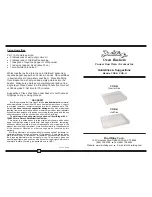
4
The SpO
2
Sensor is contraindicated for use on patients who exhibit allergic reactions to the
pressure-sensitive adhesive on the wraps.
Instructions for Use
Reusable sensors may be used on the same site for a maximum of 4 hours, provided the site is
inspected routinely to ensure skin integrity, correct positioning, and adhesion of the sensor wrap.
Because individual skin condition affects the ability of the skin to tolerate sensor placement, it
may be necessary to change the sensor site more frequently with some patients.
To apply the SpO
2
Sensor:
1. Remove the small piece of paper backing from the sensor wrap.
(1)
2. To secure the wrap to the sensor, push the “button” on the black sensor pad through the
hole, as shown.
(2)
3. Remove the remainder of the paper backing. Push the “button” on the white sensor pad
through the remaining hole.
(3)
4. The sensor and wrap are now ready to be applied to the patient. Select an appropriate site as
described below.
(4)
Note:
When placing the SpO
2
Sensor on a finger or toe, the WHITE sensor pad must be placed on the
NAIL SIDE.
Note:
When selecting a sensor site, priority should be given to an extremity free of an arterial catheter,
blood pressure cuff, or intravascular infusion line.
Neonate (1–3 kg)
: The preferred site is a foot, proximal to the toes with the cable positioned along
the side of the foot. Alternatively, place the sensor around the palm of a hand, with the cable
positioned along the side of the hand.
Infant (3–15 kg)
: The preferred site is around a great toe with the cable positioned along the side
of the foot.
Pediatric (15–40 kg)
: The preferred site is around an index finger with the cable positioned along
the medial side of the finger. Alternative sites are around a thumb, finger, or a great toe.
Adult (> 40 kg)
: The preferred site is around an index finger with the cable positioned along the
medial side of the finger. Alternatively, use a thumb, a smaller finger, or a great toe.
5. Position the sensor so that the electronic components are directly opposite each other and with
the sensor aligned on the side of the foot, toe, or finger so that the cable is positioned along the
appropriate surface (as described in #4 above).
6. Wrap the remaining portion of the adhesive wrap around the site, loosely enough to ensure good
circulation.
7. Plug the sensor into the instrument as described in the instrument operator’s manual, and verify
proper operation.
Note:
If the sensor does not track the pulse reliably, it may be incorrectly positioned—or the sensor
site may be too thick, thin, or deeply pigmented, or otherwise deeply colored (for example, as
a result of externally applied coloring such as nail polish, dye, or pigmented cream) to permit
appropriate light transmission. If any of these situations occurs, reposition the sensor or choose
an alternate Nellcor sensor for use on a different site.
Summary of Contents for Nellcor D-YS
Page 2: ...2 4 3 2 1...
Page 50: ...50 SpO2 4 SpO2 1 1 2 2 3 3 4 4 SpO2 1 3 3 15 15 40 40 5 4 6 7...
Page 51: ...51 Nellcor D YS 70 10 5 5 25 1 2 3 1 2 3 10 4 5 10 6 7...
Page 52: ...52 1 SpO2 2 1 SpO2 2 SpO2 3 4 Nellcor 5 6 7 8 9...
Page 54: ...54 Nellcor Nellcor Nellcor Covidien Covidien Covidien...
Page 56: ...56 SpO2 4 SpO2 1 1 2 2 3 3 4 4 SpO2 1 3 3 15 15 40 40 5 4 6 7 Nellcor...
Page 57: ...57 D YS 70 1 10 5 5 25 1 2 3 1 2 3 10 4 5 10 6 7 1 SpO2 MRI MRI 2 1 SpO2 2 SpO2...
Page 76: ...76 D YSPD SpO2 4 SpO2 1 1 2 2 3 3 4 4 SpO2 1 3 kg 3 15 kg 15 40 kg o...
Page 77: ...77 40 kg to 5 4 6 7 Nellcor D YS 70 1 10 5 5 25 1 2 3 1...
Page 78: ...78 2 3 10 4 5 10 6 7 1 SpO2 2 1 SpO2 2 SpO2 3 4 4 Nellcor 5 6...
Page 80: ...80 Nellcor Nellcor Nellcor Covidien Covidien Covidien...
Page 86: ...86 THIS PAGE INTENTIONALLY LEFT BLANK...





































